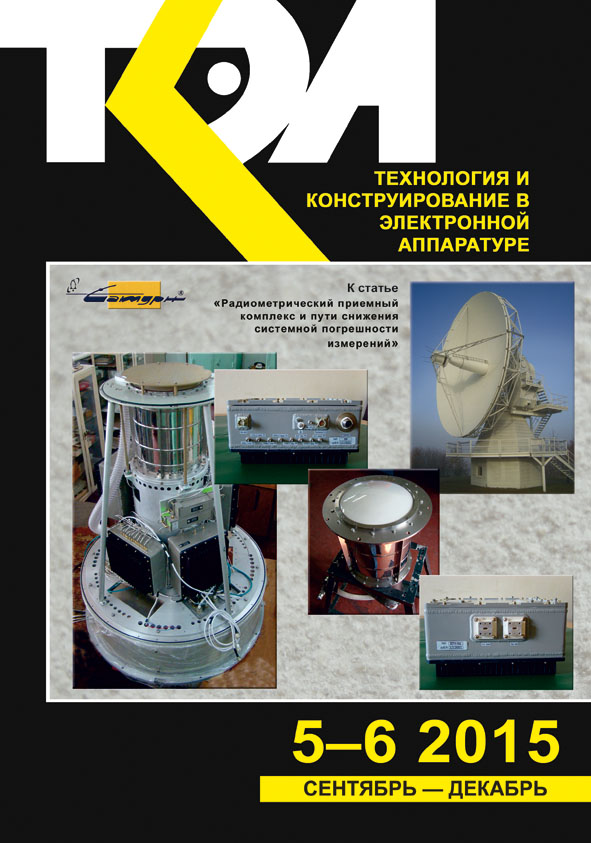Simulating characteristics of Si/Ge tandem monolithic solar cell with Si1-xGex buffer layer
Моделирование характеристик тандемного монолитного солнечного элемента Si/Ge с буферным слоем Si1–хGeх
Abstract
In spite of many efforts to propose new semiconductor materials and sophisticated constructions of solar cells, crystalline silicone remains the main photovoltaic material widely used up to now. There are various methods to enhance the efficiency of silicone solar cells. One of them is to combine silicone with an additional semiconductor material with the different bandgap to form a tandem construction. For example, the germanium sub-cell used as the bottom cascade for the silicone sub-cell in the tandem monolithic solar cell makes it possible to utilize the "red" sub-band of solar spectra increasing overall solar cell efficiency. The problem of the 4.2% mismatch in lattice constant between Si and Ge can be resolved in such a case by the use of SiGe buffer layer. In the paper the results of the computer simulation for Si/Ge tandem monolithic solar cell with Si1-xGex buffer layer are presented. In the solar cell under consideration, the step graded Si1-xGex buffer layer is located between the top silicone and the bottom germanium cascades to reduce the threading dislocation density in mismatched materials. The cascades are commutated by the use of the germanium tunnel diode between the bottom sub-cell and the buffer layer. For the solar cell modeling, the physically-based device simulator ATLAS of Silvaco TCAD software is employed to predict the electrical behavior of the semiconductor structure and to provide a deep insight into the internal physical processes. The voltage-current characteristic, photovoltaic parameters and the distribution of basic physical values are obtained for the investigated tandem solar cell. The influence of layer thicknesses on the photovoltaic parameters is studied. The calculated efficiency of the tandem solar cell reaches 13% which is a quarter more than the efficiency of a simple silicone solar cell with the same constructive parameters and under the same illumination conditions.
References
Luque A., Hegedus S. Handbook of photovoltaic science and engineering. John Wiley & Sons Ltd, 2003, 1138 p.
Ringel S.A., Carlin J.A., Andre C.L., Hudait M.K., Gonzalez M., Wilt D.M., Clark E.B., Jenkins P., Scheiman D., Allerman A., Fitzgerald E.A., Leitz C.W. Single-junction InGaP/GaAs solar cells grown on Si substrates with SiGe buffer layers. Progress in Photovoltaics: Research and Applications, 2002, vol. 10, iss. 6, pp. 417-426. http://dx.doi.org/10.1002/pip.448
Putyato M.A., Semyagin B.R., Emel’yanov E.A., Pakhanov N.A., Preobrazhenskii V.V. [GaAs/Si(001) molecular beam epitaxy for high-performance tandem AIIIBV/ Si sun energy converters on active Si substrate]. Izvestiya vuzov: Fizika, 2010, no. 9, pp. 26-33. (Rus)
Fitzgerald E.A., Currie M.T., Samavedam S.B., Langdo T.A., Taraschi G., Yang V., Leitz C.W., Bulsara M.T. Dislocations in relaxed SiGe/Si heterostructures. Phys. Status Solidi (a), 1999, no. 171, pp. 227-238. https://surli.cc/htmgxi
Zulkefle A.A., Zainon M., Zakaria Z., Sopian K., Amin N. Numerical modeling of silicon/germanium (Si/Ge) superlattice solar cells. Proc. of the 7-th WSEAS Int. Conf. On Renewable energy sources, Kuala Lumpur, Malaysia, 2013, pp. 233-237.
Varonides A.C. High Efficiency Solar Cells via Tuned Superlattice Structures: Beyond 42,2%. In book: Solar cells — new aspects and solutions, chapter 15, ed. by L. Kosyachenko, InTech, 2011. http://dx.doi.org/10.5772/23510
Sun G., Chang F., Soref R.A. High efficiency thin-film crystalline Si/Ge tandem solar cell. Optics express, 2010, vol. 18, iss. 4, pp. 3746-3753. http://dx.doi.org/10.1364/OE.18.003746
Glushko A.A., Rodionov I.A., Makarchuk V.V. [Simulating submicron KMOP SBIS technology using TCAD]. Tekhnologiya i Konstruirovanie v Elektronnoi Apparature, 2007, no. 4, pp. 32-34. (Rus)
Simulation Standard: Simulating Solar Cell Devices Using Silvaco TCAD. 2008, vol. 18, no.2, pp. 1-3.
ATLAS User’s Manual. Santa Clara, CA, Silvaco, 2004.
Gnilenko A.B., Dzenzersky V.A., Plaksin S.V., Pogorelaya L.M. [The investigation of silicon wafer thickness influence on characteristics of multijunction solar cells with vertical p—n junctions]. Tekhnologiya i Konstruirovanie v Elektronnoi Apparature, 2012, no. 1. pp. 27-29.
Gnilenko A.B., Dzenzersky V.A., Plaksin S.V., Pogorelaya L.M. [Simulating Si Solar Cell with vertical p—n junction]. Vidnovlyuvana energetyka, 2013, no. 2, pp. 37-44. (Rus)
Pol’skii B.C. Chislennoe modelirovanie poluprovodnikovykh priborov [Numerical simulating semiconductor devicis]. Riga, Zinatne, 1986, 168 p. (Rus)
Copyright (c) 2015 Gnilenko A. B., Lavrich Ju. N., Plaksin S. V.

This work is licensed under a Creative Commons Attribution 4.0 International License.

